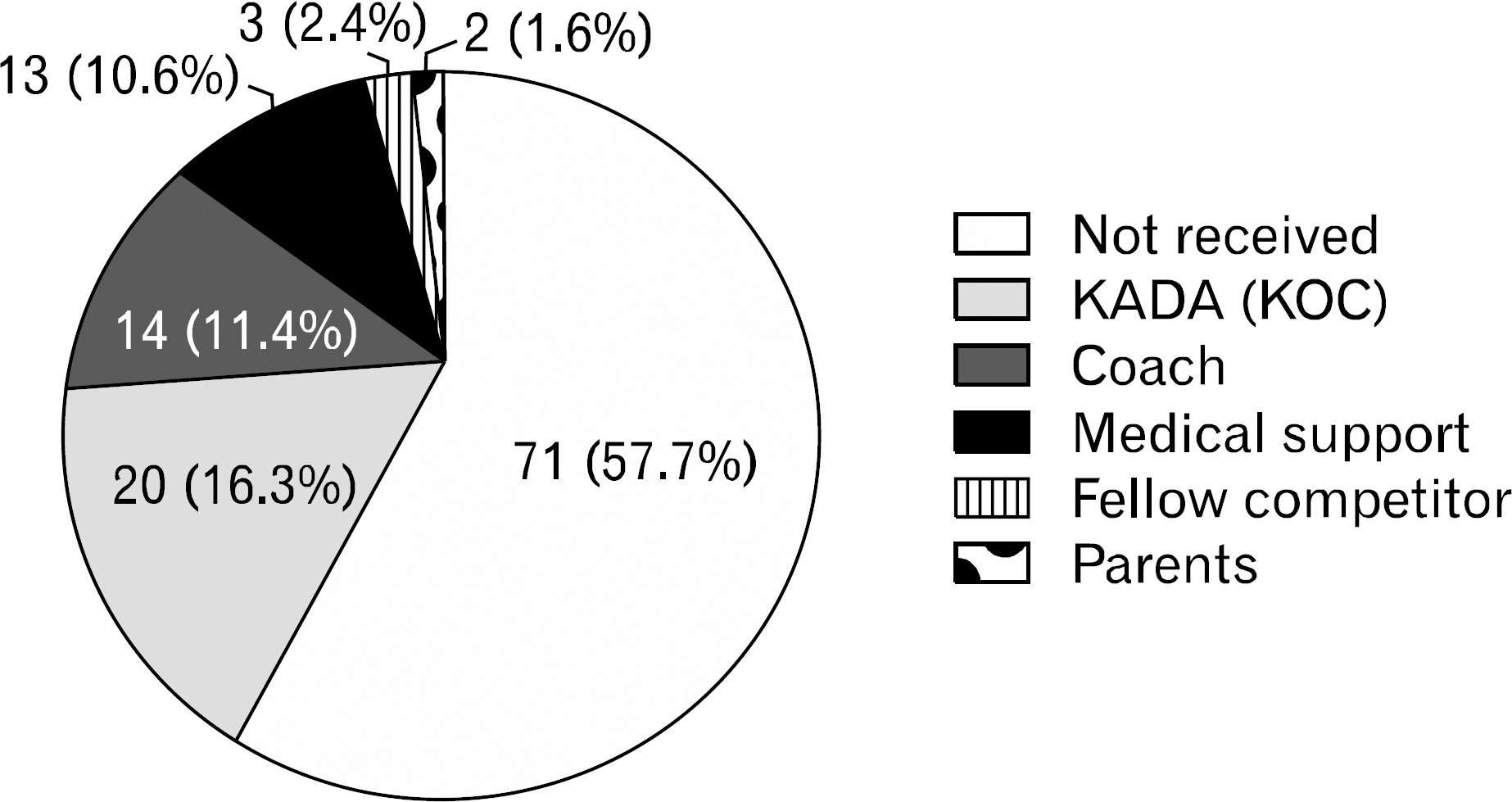Abstract
For effective prevention of doping, individual and situational factors that make an elite athlete more susceptible to doping than others should be investigated. The aim of this study was to quantitatively measure doping related attitudes and dispositions of adolescent competitive athletes at elite level. Data were collected by questionnaires among athletes (n=123) who were participating in the 2nd Asian Youth Games. Outcome measures included doping knowledge, behavior and attitude (performance enhancement attitude scale, PEAS). One athlete admitted the past use of doping and 2 athletes reported that they knew others who had doped. Athletes were mainly provided with anti-doping information from anti-doping agency (16.3%), coaches (11.4%) or medical staffs (10.6%). The average PEAS score was 38.39±11.36. High school (elder) athletes showed higher PEAS score (39.63±11.35) than middle school (younger) athletes (34.53±10.67) and team sport athletes showed lower PEAS score (35.11±9.80) than athletes in endurance (45.08±15.49) or motor skill sports (43.25±9.08). This study suggests that many factors play an important role in athlete's decisions regarding the use of doping. Further research should incorporate these factors to understand the complexity of doping and to identify points for effective anti-doping program.
Go to : 
References
1. Schneider AJ, Butcher RB. The Olympic ideal and doping: why they married, and why they should divorce. In: Pro-ceeding of the International Symposium, Sport the third millennium;. 1990. May 21–25; Quebec, Canada. Quebec: Presses Universite Laval; 1991. p. 494–501.
2. Manouchehri J, Tojari E. Development and validation of instruments to measure doping attitudes and doping beliefs. Eur J Exp Biol. 2013; 3:183–6.
3. Verroken M. Drug use and abuse in sport. Baillieres Best Pract Res Clin Endocrinol Metab. 2000; 14:1–23.

4. Anshel MH. Substance use: chemical roulette in sport. Murphy SM, editor. The sport psych handbook. Champaign, IL: Human Kinetics;2005. p. 255–76.
5. Petroczi A. Attitudes and doping: a structural equation analysis of the relationship between athletes' attitudes, sport orientation and doping behaviour. Subst Abuse Treat Prev Policy. 2007; 2:34.

6. Morente-Sanchez J, Zabala M. Doping in sport: a review of elite athletes' attitudes, beliefs, and knowledge. Sports Med. 2013; 43:395–411.

7. Alaranta A, Alaranta H, Holmila J, Palmu P, Pietila K, Helenius I. Self-reported attitudes of elite athletes towards doping: differences between type of sport. Int J Sports Med. 2006; 27:842–6.

8. Yesalis CE, Bahrke MS. Doping among adolescent athletes. Baillieres Best Pract Res Clin Endocrinol Metab. 2000; 14:25–35.

9. Gomez JE. Performance-enhancing substances in adolescent athletes. Tex Med. 2002; 98:41–6.
10. Koch JJ. Performance-enhancing: substances and their use among adolescent athletes. Pediatr Rev. 2002; 23:310–7.

11. Calfee R, Fadale P. Popular ergogenic drugs and supplements in young athletes. Pediatrics. 2006; 117:e577–89.

12. Dunn M, White V. The epidemiology of anabolic-androgenic steroid use among Australian secondary school students. J Sci Med Sport. 2011; 14:10–4.

13. Barkoukis V, Lazuras L, Tsorbatzoudis H. Beliefs about the causes of success in sports and susceptibility for doping use in adolescent athletes. J Sports Sci. 2013 Sep 9. [Epub].http://dx.doi.org/10.1080/02640414.2013.819521.

14. Petroczi A. Measuring attitude toward doping: further evidence for the psychometric properties of the performance enhancement attitude scale. In: 14th congress of the European Association for Sport Management;. 2006. Sep 6–9; Nicosia, Cyprus.
15. Kim JK, Kang SK, Chun YS, Jung SH. Association between anti-doping awareness and dietary supplementary use in Korean elite junior athletes. Korean J Exer Nutr. 2010; 14:175–81.
16. Chun YS, Kang SK, Kim JK. The use of nutritional ergogenic aids and doping awareness by anti-doping education in Korean international team athletes. Korean J Phys Edu. 2010; 49:437–45.
17. Moran A, Guerin S, Kirby K, MacIntyre T. The development and validation of a doping attitudes and behaviour scale. Research report to World Anti-Doping Agency and The Irish Sports Council [Internet]. Ireland: UCD School of Psychology;2008. [cited 2013 Nov 15]. Available:. http://www.wada-ama.org/rtecontent/document/moran_final_report.pdf.
18. Anshel MH. A survey of elite athletes on the perceived causes of using banned drugs in sport. J Sport Behav. 1991; 14:283–307.
19. Peretti-Watel P, Guagliardo V, Verger P, Mignon P, Pruvost J, Obadia Y. Attitudes toward doping and recreational drug use among French elite student-athletes. Sociol Sport J. 2004; 21:1–17.

20. Lucidi F, Zelli A, Mallia L, Grano C, Russo PM, Violani C. The social-cognitive mechanisms regulating adolescents' use of doping substances. J Sports Sci. 2008; 26:447–56.

21. Waldron JJ, Krane V. Whatever it takes: health compromising behaviors in female athletes. Quest. 2005; 57:315–29.

22. Laure P, Binsinger C. Doping prevalence among preadol-escent athletes: a 4-year follow-up. Br J Sports Med. 2007; 41:660–3.

23. Chun YS, Lee KE, Jung SS, Lee KW, Kang SK, Kim JK. Nutritional supplements and doping consciousness in judo athletes. Korean J Exer Nutr. 2005; 9:247–52.
24. Chun YS. Nutritional supplements and doping consciousness in Korea international judo team: a longitudinal study on comparison of 2003yr, 2005yr, 2007yr. Korean J Phys Edu. 2008; 47:479–88.
Go to : 
 | Fig. 1.Analysis of sources of anti-doping information. KADA: Korea Anti-Doping Agency, KOC: Korean Olympic Committee. |
Table 1.
Characteristics of participants and differences in doping attitudes between demographic groups
Table 2.
Performance enhancement attitude scale (PEAS) scores in each sport
Table 3.
Differences in performance enhancement attitude scale (PEAS) scores between sport types
Appendix 1.
Performance enhancement attitude scale




 PDF
PDF ePub
ePub Citation
Citation Print
Print


 XML Download
XML Download